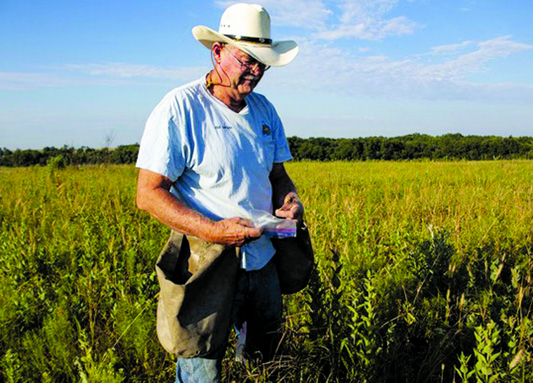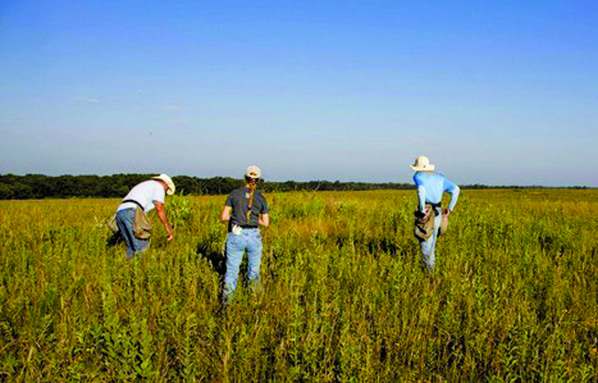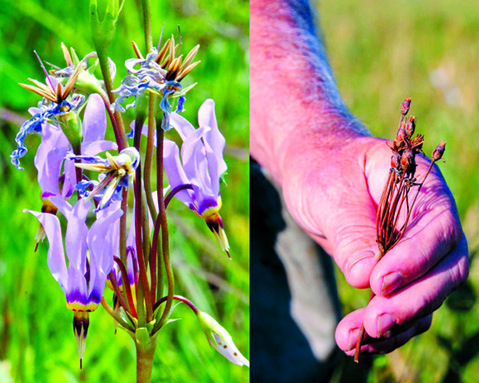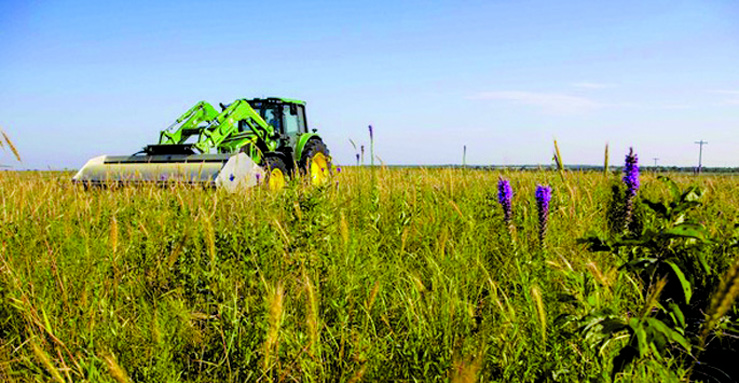 His twenty years afield collecting seed to boost Missouri’s native grasslands
His twenty years afield collecting seed to boost Missouri’s native grasslands
Most people walk onto a prairie in mid-summer and notice lush green growth speckled with purple blazing star spikes and yellow coneflowers. Rick Swopes sees more. He notes what wildflower plants were held back by a cold spring and which are thriving despite summer drought and a sweltering late-July sun. Most importantly, he knows which plant’s seeds are mature and ready to pick for the future of Missouri’s native grasslands.
For 20 years, Swopes has collected native prairie seed for the Missouri Department of Conservation (MDC) and The Nature Conservancy (TNC). His experience-sharpened eyes spot textures, shapes, and colors among plants growing on never-plowed prairies. That’s important because less than one-tenth of one percent of the state’s once-vast prairie grasslands remain. Seed collection, science-based and meticulous, provides a genetically diverse seed source for renewal. The assorted grains, pips, and kernels collected by the MDC seed crew led by Swopes will help revitalize native grasslands to serve people, wildlife, and ranching. For Swopes, 70, a farmer raised on a farm near Roscoe north of El Dorado Springs, the prairies were a mid-life revelation.
“My family has lived in that area since 1830,” Swopes said. “They were some of the first pioneers. I drove past Wah’Kon-Tah (Prairie Conservation Area) many times. But I didn’t know what was there until I walked upon it.”
Reaching for stars
The self-taught Swopes gleaned prairie knowledge by gathering seed across grasslands in all seasons. On this early July morning, he and a crew are foraging for seed south of Nevada at MDC’s Osage Prairie Conservation Area. He mainly is seeking seed from the spring blooming shooting stars in this prairie corner. But he’ll also hand pick other seed on this prairie that has more than 170 documented plant species. For shooting stars, he first looks for pink survey flags that he placed near the plants when they bloomed in April with bright lavender petals.
“If you don’t flag shooting stars in bloom, you won’t see them when they’re seeding,” Swopes said. Although, his experience helps him find the unmarked ones, too. “There’s a shooting star right there that didn’t get marked. You just have to develop an eye for it.”
Swopes bent down, pushed back grass, and pulled up a stalk with light-brown pods holding tiny seeds. He placed the pods into a labeled plastic bag. Those seeds will add diversity to the seed mix used for prairie reconstruction projects somewhere else in the Upper Osage Grasslands, an MDC priority geography for grassland restoration on public and private lands.
An MDC seed crew in the Upper Osage Grasslands collects prairie seed to enhance or restore native grasslands.

Shooting star’s lavender petals are easy to spot when they bloom in spring (left), but when they mature to seed in pods(right), they are much harder to see in a prairie’s lush summer growth. These were picked by hand.
The more common and easier to harvest seed is picked with a Flail Vac, which uses nylon brushes to sweep loose seed into a hopper. The machine does not harm prairie plants. Photos by Bill Graham, Missouri Department of Conservation
The seed crew is based at Wah’Kon-Tah Prairie in southwest St. Clair and northwest Cedar counties. From early spring through mid-November, the crew scouts, monitors, and collects seed on several virgin prairie remnants in western Missouri. Often, they work on foot and by hand. Faster collection is done by a Flail Vac machine mounted on the front of a tractor. The Flail Vac’s nylon brushes strip and collect wide swaths of mature seed quickly without damaging plants.
But some mature prairie plants have seed that will scatter quickly to the ground if even slightly disturbed. Those types are picked by hand.
“The hardest are the violets, like the ones that help that endangered regal fritillary butterfly,” Swopes said. “You have to get down on your hands and knees for those.”
Seeds of fruitful chaos
Prairie plants grow in a random but fruitful chaos dictated by soils, rainfall, sun, wind, critters spreading seeds, and sheer chance. With varied plant species, seeds ripen from spring into autumn and must be collected accordingly. That’s far different from the corn, wheat, and soybeans that farmers combine from neat rows of identical plants, the grain harvested by the truckload once a year.
But a prairie’s diverse and productive plant growth, aided by deep roots and the plants’ microbiotic partners in the soil, enables prairies to produce nutrition rich grasses and forbs for cattle and wildlife, even during a late-summer drought. For the seed harvesters though, rank green growth poses a challenge to finding target plants with seed. Swopes and his fellow MDC resource management technicians, Ryan Steffens and Jamie Nikodim, must discern what seed to harvest amid the randomness. Knowing specific details about leaves, flowers, and seed for each species is vital.
“While I’m here I’m going to pick this obedient plant,” Swopes said. “Here’s sensitive briar. The leaves fold up if you touch them. We may Flail Vac this later. You’re lucky if 50 percent of them wind up making seed. They’re mainly pollinated by bumblebees. In a cold, wet spring they don’t get pollinated as well.”
Prairie plants support the bees, butterflies, grassland birds, and assorted insects that help pollinate the flowers to produce seeds. Swopes called out plant names as he spotted them. Ripening black-eyed Susan seed heads were still a little tough, so they will be picked in a week or two. He spots Indian plantain, ashy sunflowers, prairie parsley, yarrow, various native grasses and sedges, rosin weed and rattlesnake master. He notes that seed from the blazing stars in bright purple stalk blooms will be picked in the fall.
“Rick is dedicated and very in tune to where specific plant species grow based on weather, management practices, and his years of field experience,” said Stasia Whitaker, MDC wildlife management biologist. “There are no books or trainings that can teach the sheer amount of knowledge Rick has gained, and most notably, that he has implemented during his career. He is always learning and gladly shares his knowledge.”
Harvest’s end
Swopes and the seed crew will finish their work in late November. MDC staff and volunteers will help mix and bag seed from dusty piles at the Wah’Kon-Tah seed shop. The seed mixes will add species to a prairie remnant on conservation areas or restore old fields to native grasslands. Scarce seed types, such as state endangered Mead’s milkweed, may be planted strategically to restore it to a remnant prairie or to boost genetic diversity in an existing population.
Curious volunteers at the seed mixing may pick up a handful and wonder what species are in their palms. Swopes can help them, pointing out species from seeds small as specks or big as grain. However, this may be his last harvest to lead. He may finally retire after years of saying he would during winter, but then going back to the prairies in the spring.
“I kind of fell in love with the prairie,” he said. “That’s the reason I’ve been reluctant to quit.”
To learn more about Missouri prairies or native grassland remnants on your property, visit https://short.mdc.mo.gov/Zts.



Facebook Comments